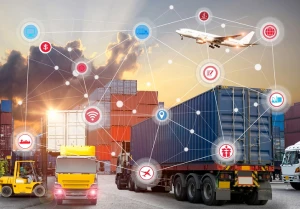Digital transformation in port management and logistics has significantly reshaped operations, improving efficiency, transparency, and sustainability. As ports and logistics companies have embraced new technologies like IoT, automation, artificial intelligence (AI), and blockchain, several key lessons have emerged from their transformation efforts:
- Data-Driven Operations are Essential for Efficiency
- Lesson: Leveraging data analytics is critical to optimizing port operations, logistics workflows, and decision-making.
- Challenge: Early adopters faced difficulties integrating siloed data systems and poor-quality data from disparate sources, limiting their ability to make informed decisions.
- Takeaway: Centralizing data from various sources (ships, trucks, warehouses, etc.) onto unified platforms is key. Real-time analytics, predictive models, and AI-based insights improve throughput, streamline cargo movement, and reduce bottlenecks in busy ports.
- Automation Increases Productivity but Requires Workforce Adaptation
- Lesson: Automating routine tasks, such as cargo handling, warehousing, and container movements, increases productivity and reduces operational costs.
- Challenge: Initial deployments of automation faced resistance from workers fearing job displacement, and there were integration issues with legacy equipment.
- Takeaway: Successful automation projects combine technology adoption with workforce retraining and adaptation. Human workers must be upskilled to manage and oversee automated systems. Ports using automated cranes, self-driving vehicles, and AI-based scheduling systems have seen reduced delays and improved productivity.
- IoT and Real-Time Monitoring Enhance Operational Visibility
- Lesson: IoT devices and sensors enable real-time monitoring of cargo, ships, trucks, and port equipment, leading to better visibility and operational efficiency.
- Challenge: Early IoT implementations suffered from technical limitations, such as data latency or lack of interoperability between devices.
- Takeaway: Implementing IoT sensors across port and logistics operations provides detailed insights into cargo location, equipment performance, and environmental conditions. These insights lead to better decision-making, reduce downtime, and enable predictive maintenance for machinery and port infrastructure.
- Digital Twins Enable Real-Time Simulations and Planning
- Lesson: Digital twins—virtual models of physical port infrastructure and logistics chains—allow operators to simulate different scenarios and optimize resources.
- Challenge: Creating accurate digital twins requires large volumes of data and the integration of multiple systems, which can be technically complex.
- Takeaway: Ports using digital twins can simulate cargo flow, analyze port congestion, and optimize asset management in real-time. These simulations reduce operational risks, improve throughput, and enable more effective resource allocation.
- Blockchain Improves Transparency and Trust in Supply Chains
- Lesson: Blockchain technology enhances transparency, security, and efficiency in supply chain management by providing immutable records of cargo movements and transactions.
- Challenge: Early blockchain initiatives were hampered by concerns over scalability and interoperability with existing systems.
- Takeaway: By using blockchain for documentation, such as bills of lading and cargo tracking, stakeholders in port logistics can improve trust, reduce paperwork, and eliminate fraud. The adoption of blockchain enhances coordination between shippers, freight forwarders, and port authorities, increasing transparency throughout the supply chain.
- Collaboration Across Ecosystems is Crucial for Success
- Lesson: Ports, shipping lines, logistics companies, and government agencies must collaborate for effective digital transformation.
- Challenge: Silos and a lack of communication between stakeholders often hindered the sharing of data, resulting in inefficiencies in port operations.
- Takeaway: Digital platforms that encourage real-time information sharing between all stakeholders improve collaboration and streamline processes. For instance, data-sharing platforms that provide updates on vessel arrivals, customs clearances, and cargo movements enable better coordination, reducing delays and increasing efficiency.
- Sustainability and Green Initiatives Require Digital Tools
- Lesson: Digital technologies are key to achieving environmental sustainability goals in port management and logistics, such as reducing emissions and improving energy efficiency.
- Challenge: Balancing sustainability initiatives with profitability was initially challenging, as some green technologies were costly and lacked immediate ROI.
- Takeaway: Digital tools, such as AI-based energy management systems, predictive analytics for fuel optimization, and IoT-based environmental monitoring, can reduce carbon emissions and energy consumption. Ports that leverage smart grids, electric cranes, and automated vehicles lower their carbon footprint and comply with increasingly stringent environmental regulations.
- Cybersecurity is Paramount in a Connected Port Environment
- Lesson: As ports and logistics operations become more digital and connected, they become more vulnerable to cyber threats.
- Challenge: Many port authorities and logistics operators initially underestimated the cybersecurity risks posed by interconnected digital systems, which left their systems vulnerable to attacks.
- Takeaway: Cybersecurity must be integrated into the digital transformation strategy. Regular audits, network monitoring, and the adoption of robust security protocols (such as encryption and multi-factor authentication) are essential for protecting sensitive data and critical infrastructure from cyberattacks.
- Customer Experience is Enhanced Through Digital Platforms
- Lesson: Digital transformation can significantly improve customer experience by offering greater visibility, faster communication, and more personalized services for shipping companies and logistics providers.
- Challenge: Traditional port management and logistics systems were often opaque, with limited customer visibility into cargo movements and delays.
- Takeaway: Ports that have adopted digital customer platforms provide real-time tracking of shipments, automated notifications, and streamlined booking processes, improving customer satisfaction. These platforms enable better planning, faster responses to issues, and more efficient cargo management for clients.
- AI and Machine Learning Optimize Port and Logistics Operations
- Lesson: AI and machine learning algorithms can optimize complex operations such as vessel scheduling, cargo routing, and predictive maintenance for port equipment.
- Challenge: Initial AI implementations were slow due to the complexity of training models with large datasets and the lack of skilled talent to operate AI systems.
- Takeaway: AI helps forecast demand, predict vessel arrival times, optimize container storage locations, and reduce equipment downtime through predictive maintenance. Ports that use AI for decision-making reduce operational costs and improve the overall efficiency of their supply chain.
- Digital Infrastructure Investments Must Be Scalable
- Lesson: Digital transformation requires scalable infrastructure to accommodate future growth in cargo volumes and technological advancements.
- Challenge: Some early digital initiatives were limited in scope and scalability, leading to bottlenecks as ports expanded or new technologies emerged.
- Takeaway: Ports must invest in scalable digital infrastructure, such as cloud-based platforms, to accommodate growing data needs and adapt to future technological innovations. This allows ports to manage increasing volumes of cargo while maintaining operational efficiency and flexibility.
- Leadership and Change Management are Key to Digital Success
- Lesson: Successful digital transformation in port management and logistics requires strong leadership and a commitment to change management throughout the organization.
- Challenge: Resistance to change from within the organization, particularly from older or traditional departments, can slow down or derail digital initiatives.
- Takeaway: Leadership must drive the digital transformation agenda and foster a culture that embraces innovation and continuous learning. Effective change management, including clear communication and employee engagement, helps overcome resistance and ensures that the entire organization is aligned with digital goals.
Summary of Key Lessons:
- Data integration and analytics are critical for optimizing port and logistics operations, enhancing decision-making, and improving transparency.
- Automation and AI boost productivity, but workforce adaptation and retraining are essential for successful implementation.
- IoT and real-time monitoring provide operational visibility, enabling better decision-making and predictive maintenance.
- Digital twins allow real-time simulations, optimizing cargo flow, resource allocation, and infrastructure management.
- Blockchain technology enhances transparency, security, and efficiency in supply chains.
- Collaboration across the ecosystem is necessary for successful digital transformation, enabling seamless data exchange and improved coordination.
- Sustainability goals can be achieved with the help of digital tools that optimize energy usage and reduce emissions.
- Cybersecurity must be prioritized to protect interconnected systems and sensitive data.
- Customer experience is improved through digital platforms that offer real-time visibility and personalized services.
- Scalability of digital infrastructure is key to accommodating future growth and technological advancements.
- Leadership commitment and change management are essential for driving digital transformation and overcoming resistance to change.
These lessons demonstrate how digital transformation can revolutionize port management and logistics, improving operational efficiency, enhancing customer service, and increasing resilience to future challenges. By learning from these insights, the industry can better navigate the ongoing evolution and position itself for long-term success.





